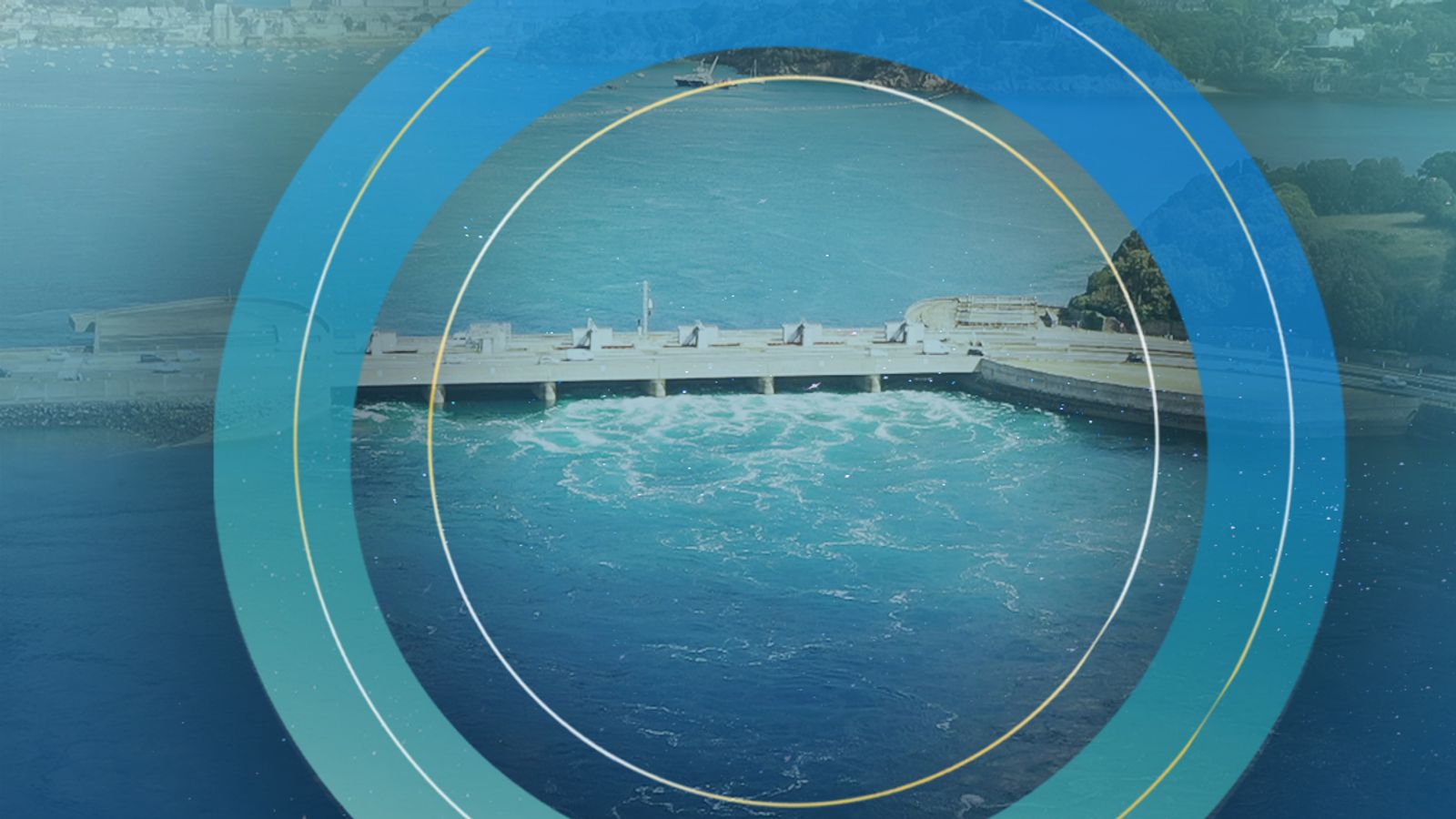The strong tides along Britain’s west coast could produce huge amounts of clean electricity for less than the cost of nuclear, Sky News has been told.
The country has the second biggest tides in the world after Canada, peaking in the Bristol Channel, and along the coasts of north Wales and northwest England.
According to experts, a network of seven tidal power plants could be built by 2030, generating enough electricity for more than four million homes.
And because tide times are known far into the future, the power would be far more predictable than other renewable sources such as wind and solar.
Yet the government’s energy strategy only mentions the potential in passing. Instead, the priority is given to nuclear energy, with eight new reactors planned.
Professor Roger Falconer, a leading consultant in water and environmental engineering, told Sky News: “It’s a big miss.
“Tidal is a natural resource with tremendous opportunities and we should be seizing them.”
Britain could reach 40C by mid-July, forecast computer models predict for first time
Wine production boom expected as climate crisis recreates Champagne conditions in UK, study predicts
Revealed: How much ‘electric households’ are saving on bills
There are two ways of capturing energy from the tides.
One involves anchoring small turbines in areas with a rapid flow of seawater, such as between the Orkney Islands where some prototypes are being tested.
But, like wind turbines, large numbers would be needed to make a meaningful contribution to the UK energy supply.
Engineers say a far bigger potential is in capturing energy from tidal range, the difference in height between high and low tide.
This could be done by building a dam, or barrage, across a river estuary, or building a circular seawall to create a lagoon.
Energy is captured by channeling the rise and fall of the sea through turbines in the structure.
Prof Falconer said one project in west Somerset would have a capacity of 2.5GW – almost as much as the Hinkley Point C nuclear reactor just up the coast.
But whereas the reactor has cost £26bn to build so far, the tidal lagoon project would cost just £8.5bn.
“Yet while the west Somerset lagoon would last for 120 years, a nuclear reactor will only last 60 years,” said Prof Falconer.
“And then you have radioactive waste that needs to be managed for many centuries into the future.”
He said governments are put off tidal energy by the upfront cost, but by using the same funding mechanisms that are used for even more expensive nuclear projects, the cost of electricity would be around £74 per megawatt-hour (MWh).
By comparison, the price of electricity generated at Hinkley Point C was set at £92.50 per MWh in 2012, rising with inflation.
“We desperately need to do something,” said Prof Falconer.
‘The age of tidal has come’
In Liverpool, plans are being drawn up for a tidal power station across the River Mersey or further out in the bay.
But to the frustration of Steve Rotheram, the metro mayor for the region, the scheme is struggling to win support from the UK government.
He told Sky News that the Treasury wants to see a return on investment within 40 years, yet the tidal plant would produce energy for well over a century.
“It’s difficult to compete when you have an unfair methodology of deciding whether something gets funded or not.
“Of course, the outlay is eye-watering – £6bn. But this project could generate enough energy for a million homes for 120 years.
“The return over those years more than passes muster.”
He added that the government “needs to have confidence that the age of tidal has come”.
“Not only would it be great for UK plc, but we could export the technology around the world, creating jobs,” Mr Rotheram said.
“The government doesn’t consider some of these factors. If they did the project more than washes its face.”
One tidal plant already exists in France
There is so far only one tidal range power plant in Europe, run by EDF at the Rance river in northern France.
Turbines are built into a dam that stretches across the estuary, producing enough electricity for 220,000 people.
Sky News was taken down into one of the 6m-wide turbines that had been drained for maintenance.
The structure was built in 1966, for a cost of almost £1bn in today’s money.
But François Régis Chevreau, the director of the plant, said it was excellent value.
“Yes, it cost a lot to build such a plant,” he said.
“But we produce around 15% of the electricity that Brittany uses in a year.
“And as we will use it for decades, maybe for centuries, we will get the money back.”
What about the environmental impact?
The plant has disturbed the habitat of marine creatures that live in the estuary.
Prof Falconer said environmental impact must be tracked and mitigated as much as possible.
But he said all energy plants have some kind of impact, whether it was carbon dioxide from gas power stations or the installation of solar panels on agricultural land.
“No power generation is without a disbenefit,” he said.
But, despite strong evidence in favour of tidal energy, the UK government is still holding back.
Please use Chrome browser for a more accessible video player
The Department for Business, Energy and Industrial Strategy said: “The government remains open to considering well-developed proposals for harnessing the tidal range energy in the bays and estuaries around our coastlines, including barrage schemes and other alternatives.
“Any proposal would need to demonstrate strong evidence of value for money before the government could take a view on its potential.”
Mr Rotheram said tidal energy “more than passes muster” and the government “needs to have confidence that the age of tidal has come”.
“Not only would it be great for UK plc, but we could export the technology around the world, creating jobs,” he said.
“The government doesn’t consider some of these factors. If they did the project more than washes its face.”
Watch the Daily Climate Show at 3.30pm Monday to Friday, and The Climate Show with Tom Heap on Saturday and Sunday at 3.30pm and 7.30pm.
All on Sky News, on the Sky News website and app, on YouTube and Twitter.
The show investigates how global warming is changing our landscape and highlights solutions to the crisis.










